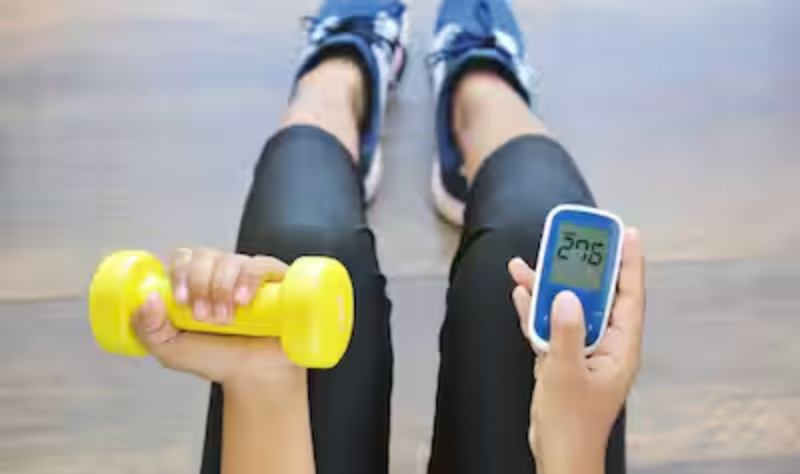Taming the blood sugar roller coaster is a familiar challenge for diabetics. While diet plays a crucial role, incorporating regular exercise is your secret weapon for achieving optimal blood sugar control and unlocking a world of fitness benefits. This comprehensive guide explores how exercise empowers you to manage diabetes effectively, unveils a variety of exercise options, and provides practical tips to transform yourself into a fit and healthy diabetic warrior.
Why Exercise Matters for Diabetics
Exercise acts like magic for blood sugar control. Here’s how:
- Boosts Insulin Sensitivity: Regular physical activity improves your body’s ability to utilize insulin, the hormone that unlocks your cells and allows glucose (sugar) to enter for energy. This translates to lower blood sugar levels.
- Burns Calories and Manages Weight: Exercise helps you burn calories and maintain a healthy weight, which further improves insulin sensitivity and blood sugar control.
- Reduces Inflammation: Physical activity combats chronic low-grade inflammation, a risk factor for type 2 diabetes and its complications.
- Improves Overall Health: Exercise strengthens your heart, improves circulation, and boosts mood, all contributing to a healthier and happier you.
Finding the Exercise Fit for You:
The beauty of exercise for diabetes management lies in its versatility. Here’s a diverse range of activities to choose from:
- Cardiovascular Exercise (Cardio): This gets your heart pumping and blood flowing. Consider brisk walking, jogging, swimming, cycling, dancing, or elliptical training. Aim for at least 150 minutes of moderate-intensity cardio or 75 minutes of vigorous-intensity cardio each week.
Beyond Cardio:
- Strength Training: Building muscle mass not only improves your physique but also enhances insulin sensitivity. Use free weights, resistance bands, or bodyweight exercises to target major muscle groups 2-3 times a week.
- High-Intensity Interval Training (HIIT): This involves alternating short bursts of intense exercise with periods of rest or low-intensity activity. HIIT offers a time-efficient way to boost your metabolism and burn calories, even after your workout ends.
- Low-Impact Activities: Gentle exercises like yoga, Pilates, or tai chi are excellent options for those with limitations or joint pain. They promote flexibility, balance, and stress reduction, all beneficial for overall well-being.
- Team Sports: Playing basketball, volleyball, or joining a fitness class adds a social element to your workout routine and can keep you motivated.
Considerations for Diabetics:
- Start Slow and Gradually Increase Intensity and Duration: Don’t jump into strenuous workouts if you’re new to exercise. Begin with low-impact activities and gradually increase intensity and duration to avoid injury and stay motivated.
- Listen to Your Body: Pay attention to your body’s signals. Rest when you need to, and don’t push yourself to the point of pain.
- Stay Hydrated: Drink plenty of water before, during, and after your workout to prevent dehydration.
- Monitor Blood Sugar Levels: Check your blood sugar before, during, and after exercise, especially if you’re taking insulin. This helps you adjust your medication or snack intake as needed.
- Wear Proper Footwear: Invest in comfortable, supportive shoes to prevent foot injuries.
- Be Aware of Diabetic Complications: If you have nerve damage in your feet, choose exercises that minimize impact and consult with your doctor to ensure safety.
Beyond the Basics: Optimizing Your Exercise Routine
- Warm-up and Cool-down: Dedicate 5-10 minutes to light cardio and dynamic stretches before your workout, and perform static stretches afterwards to prevent injury and improve flexibility.
- Fuel Your Body: Eat a healthy snack or meal rich in complex carbohydrates and protein about 30-60 minutes before exercise to prevent hypoglycemia (low blood sugar).
- Carry a Glucagon Kit: If you take insulin, always carry a glucagon kit in case of severe hypoglycemia.
- Find a Workout Buddy: Partnering up with a friend or family member for exercise adds accountability and makes your workouts more enjoyable.
- Make it Fun: Choose activities you genuinely enjoy! Exercise shouldn’t feel like a chore. Explore different options and find what sparks your motivation.
Breaking Down Barriers: Overcoming Exercise Obstacles
- Lack of Time: Break down your workout into smaller chunks. Aim for 30 minutes a day, but you can even split it into two 15-minute sessions. Take the stairs instead of the elevator, do some squats or lunges during commercial breaks, or park further away and walk to your destination. Every bit counts!
- Motivation Slump: Combat motivation dips by setting realistic goals, tracking your progress (a fitness tracker can help!), and rewarding yourself for achieving milestones. Explore new activities to keep things interesting.
- Cost Concerns: Exercise doesn’t have to be expensive. Utilize free resources like bodyweight exercises, walking/running outdoors, or free online workout videos. Many community centers offer affordable fitness classes.
- Physical Limitations: Don’t let limitations hold you back. Talk to your doctor about safe and effective exercise options tailored to your specific needs. Water exercises are a fantastic low-impact option, and chair-based exercises offer a safe way to stay active.
Embrace the Journey: Transforming Your Mindset
Shifting your perspective from “exercise for diabetes control” to “exercise for a healthier, happier me” empowers a sustainable lifestyle change. Here are some tips:
- Focus on How You Feel: Notice the positive changes exercise brings – increased energy, improved mood, better sleep. Let these positive feelings fuel your motivation.
- Celebrate Non-Scale Victories: Don’t get fixated solely on the number on the scale. Celebrate improvements in stamina, flexibility, or completing a challenging workout.
- Join a Support Group: Connecting with others who understand the challenges of diabetes can be a source of motivation and encouragement.
Living a Fit and Healthy Life with Diabetes
By incorporating regular exercise into your routine, you’re not just managing blood sugar – you’re investing in your overall well-being. Exercise empowers you to feel stronger, more energized, and in control of your health. Remember, consistency is key. Find activities you enjoy, make them a part of your lifestyle, and celebrate your journey towards a fit and healthy future with diabetes!
Bonus Section: Sample Workout Routines
Sample Beginner Workout:
- 30 minutes of brisk walking (warm-up for 5 minutes, cool down for 5 minutes)
- Strength training (2 sets of 10-12 repetitions for major muscle groups using bodyweight exercises or light weights)
Sample Intermediate Workout:
- 30 minutes of interval training (alternate between high-intensity activity like jogging for 30 seconds and low-intensity activity like brisk walking for 1 minute)
- Strength training (3 sets of 12-15 repetitions for major muscle groups using weights or resistance bands)
Sample Advanced Workout:
- 45 minutes of running, cycling, or swimming
- Strength training (4 sets of 15-20 repetitions for major muscle groups using weights or resistance bands)
Remember, these are just samples. Always consult with your doctor before starting a new exercise program, especially if you have any health concerns.

 Diabetology2 weeks ago
Diabetology2 weeks ago
 Diabetology2 weeks ago
Diabetology2 weeks ago
 Diabetology1 week ago
Diabetology1 week ago
 Diabetology1 week ago
Diabetology1 week ago
 Diabetology1 week ago
Diabetology1 week ago
 Diabetology2 weeks ago
Diabetology2 weeks ago
 Diabetology1 week ago
Diabetology1 week ago
 Diabetology2 weeks ago
Diabetology2 weeks ago








